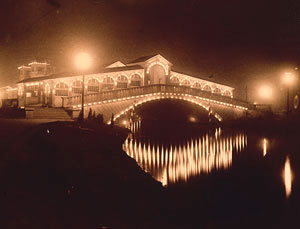
Tennessee Centennial Exposition
The Tennessee Centennial Exposition, held in Nashville in 1897 to celebrate Tennessee’s one-hundredth anniversary of statehood, was one of the largest and grandest of a series of industrial expositions that became hallmarks of the New South era. Modeled in particular after the Chicago Columbian Exposition in 1893, it featured exhibitions on the industry, agriculture, commerce, and transportation of the state as well as displays on the educational and cultural achievements. Torn by jealousy among the three grand divisions and stymied by the deadening effects of the 1893 depression, the state’s centennial celebration did not begin until one year after the one-hundredth anniversary of statehood. A group of Nashville businessmen took the lead in planning the exposition, and the Louisville and Nashville Railroad provided major backing for the event, which became, in part, a public relations effort to appease widespread public discontent with the railroad monopolies. Two chief officers of the Nashville, Chattanooga, and St. Louis Railroad, John W. Thomas and Eugene C. Lewis, served as president and director general, respectively, of the exposition.
The exposition grounds were an important experiment in city planning and park design. They were built upon the model of the Chicago Columbian Exposition, which inspired the City Beautiful Movement. Laid out on the grounds of a former race track about three miles west of the city center on West End Avenue, the exposition featured neoclassical buildings, a man-made lake, curvilinear roads, and elaborate landscaping. Centennial City was also granted full powers as a separate city, and it became a model of Progressive era “good government” with its strict regulations of liquor and vice.
The Centennial Exposition was, above all, a celebration of technological progress brought by the machine age. Major exhibits were devoted to commerce, agriculture, machinery, and transportation. The typical exhibits included a relic of some outmoded method or contraption and the modern technology that had replaced it. Thus, an old cotton bale press powered by a plodding mule was set in “striking contrast” to the steam-powered model of the present day, and an old hand loom or spinning wheel was put beside new electric powered textile machinery. There were in addition automatic brick makers, telephones, gasoline engines, electric dynamos, electric lights strung on every building, all offered as evidence of the promise of technological progress in the New South.
The exposition also gave much attention to the social progress of the “new woman,” the “new Negro,” and the modern child. Tennessee women played a particularly prominent role in the exposition, which served to galvanize women reformers of the Progressive era. The Woman’s Building featured displays of domestic arts and home economics and sponsored visiting lectures by Jane Addams and other leaders of the emerging feminist movement. The Negro Building was filled with displays of African American products and educational achievements. Advocates of racial progress and cooperation were invited to address the exposition, and several Negro Days were set aside to honor the free, educated, aspiring “new Negro.” The celebration of black progress at the exposition, along with the strict segregation of the races, reflected the paradoxical racial politics of the New South, however. A Children’s Building put on display children’s art work and hosted lectures on school reform. Throughout the exposition there was an ever-present emphasis on improvement through science, technology, and education.
Along with the celebrations of technological and social progress were major exhibits devoted to art and history. To house the Fine Arts Building, an exact scale model of the Parthenon of ancient Greece was erected at the center of the exposition grounds. It soon became the most admired building on the grounds. Symbol of Nashville’s traditional claim as the “Athens of the South,” this plaster and wood version of the Parthenon remained standing until the 1920s, when it was rebuilt in concrete. The history of the state was also honored by the Tennessee Historical Society, which exhibited artifacts and manuscripts from the state’s early history. The Ladies’ Hermitage Association, the Colonial Dames, and the Daughters of the American Revolution joined in displaying artifacts depicting the state’s history. The Confederate Memorial Association, a women’s organization devoted to raising monuments to the Lost Cause, organized a special display on the “late war,” while the Grand Army of the Republic offered artifacts depicting the Northern side of the war. One of the chief functions of this and other southern expositions was to put on display the New South spirit of reconciliation with the North. Among the more dramatic examples of this was the Confederate Veteran’s Day, which drew sixteen thousand former rebels to Nashville to honor the Lost Cause and celebrate the South’s new place within the Union.
In addition to the exhibits displaying Tennessee’s economic, social, and cultural progress, the Centennial Exposition included a midway with exciting rides and exotic shows for the entertainment of the families attending. The Tennessee Centennial Exposition opened May 1, 1897, and closed six months later. It drew approximately 1.8 million visitors, making it the largest of any southern exposition. Afterwards the Exposition grounds were converted to Centennial Park, which became a centerpiece of Nashville’s new city park system and a major magnet to the westward growth of suburban Nashville. A number of civic organizations that sprang from the Exposition continued to meet and influence politics and reform in Nashville and the state. Women reformers joined the Centennial Club to work on municipal reform and city beautification. Others who had cooperated in the successful planning of the exposition brought a new confidence in the Progressive era’s faith in improvement through technology, education, and the expertise of business leaders.
Suggested Reading
Don H. Doyle, Nashville in the New South (1985); Herman Justi, ed., Official History of the Tennessee Centennial Exposition (1898)



